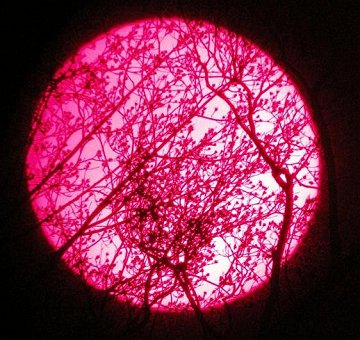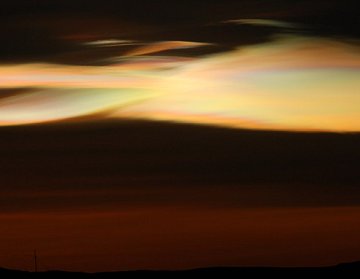| SOLAR CINEMA: Japan's Hinode spacecraft is beaming back must-see movies of a solar phenomenon called "polar crown prominences." See them in action in today's story from Science@NASA. NOT-SO-BLANK SUN: Yes, the sun is utterly blank--no sunspots. But the featureless sun is still a good target for photography, provided your neighbors have trees: 
"Yesterday, I was testing the focus on my H-alpha scope as the sun was rising," says Stephen W. Ramsden of Atlanta, Georgia. "By accident I got this weird shot of tree limbs in my neighborhood in front of the violent solar disc." Hundreds of miles away in Flower Mound, Texas, photographer Larry Alvarez reports that, while "the sun has hit rock bottom," trees are not required for a good shot. "The sun is still pure gold for the solar imager." more images: from James Kevin Ty of Manila, Philippines; from Stephen Ames of Hodgenville, Kentucky; from Alan Friedman of Buffalo, NY; from Cai-Uso Wohler of Bispingen, Germany; from N. Hebert, J. Fairfull and J. Stetson of South Portland, Maine ANTARCTIC CLOUDS: It's that time of year again; the ozone hole is opening over the South Pole. People in Antarctica need no special instruments to know this is happening. They can tell just by looking at the sky: 
"These are Type II Polar Stratospheric Clouds (PSCs) over Australia's Mawson station in Antarctica," says Andrew Klekociuk of Australia's Antarctic Division. "This type of cloud is intimately associated with the formation of the ozone hole, which is currently reaching peak size." PSCs form when temperatures in the stratosphere become extremely cold, below -78° C. ("Balloon-measured temperatures in the vicinity of the clouds were -86 degrees C," notes Klekociuk.) They spell trouble for ozone; tiny ice crystals and droplets within the clouds provide surfaces where CFCs are converted into ozone-destroying molecules. Those same crystals diffract sunlight, producing vivid nacreous colors. Peter Tsimnadis of Mawson Station took the picture using a Nikon D80 on Aug. 28th. Other similar displays have been seen since. Klekociuk says, "see our web site for more information."
Sept. 2008 Aurora Gallery
[Aurora Alerts] [Night Sky Cameras] | 
